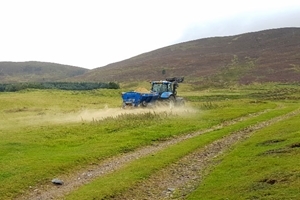 In agricultural grasslands, the application of lime is not uncommon to help maintain relatively high pH to encourage grass growth. There is some concern that this practice is waning in some areas of Scotland due to the cost of the activity and that this might have a knock-on effect on biodiversity – specifically soil invertebrates which are important in the diets of breeding waders. The James Hutton Institute (JHI) is running a trial to look into the impacts on biodiversity of lime applications and Auchnerran is one of the trial sites.
In agricultural grasslands, the application of lime is not uncommon to help maintain relatively high pH to encourage grass growth. There is some concern that this practice is waning in some areas of Scotland due to the cost of the activity and that this might have a knock-on effect on biodiversity – specifically soil invertebrates which are important in the diets of breeding waders. The James Hutton Institute (JHI) is running a trial to look into the impacts on biodiversity of lime applications and Auchnerran is one of the trial sites.
The trial was set-up in 2017 when lime was applied to half of two fields at GWSDF, following a brief period of baseline monitoring by JHI staff, looking at vegetation composition and structure, and soil biodiversity. Monitoring has continued periodically since then to record changes over time and the trial will finish in 2020.
In addition to this monitoring programme, we are also investigating the impact of lime on mud snails. With a great deal of assistance from staff at the Moredun Research Institute, we have begun searching for mud snails in damp habitats in both the limed and unlimed sections of field. These tiny molluscs are important because they can be the intermediate hosts for sheep liver fluke, so if liming of grass fields impacts on mud snails, it will have implications for fluke too and therefore sheep health.